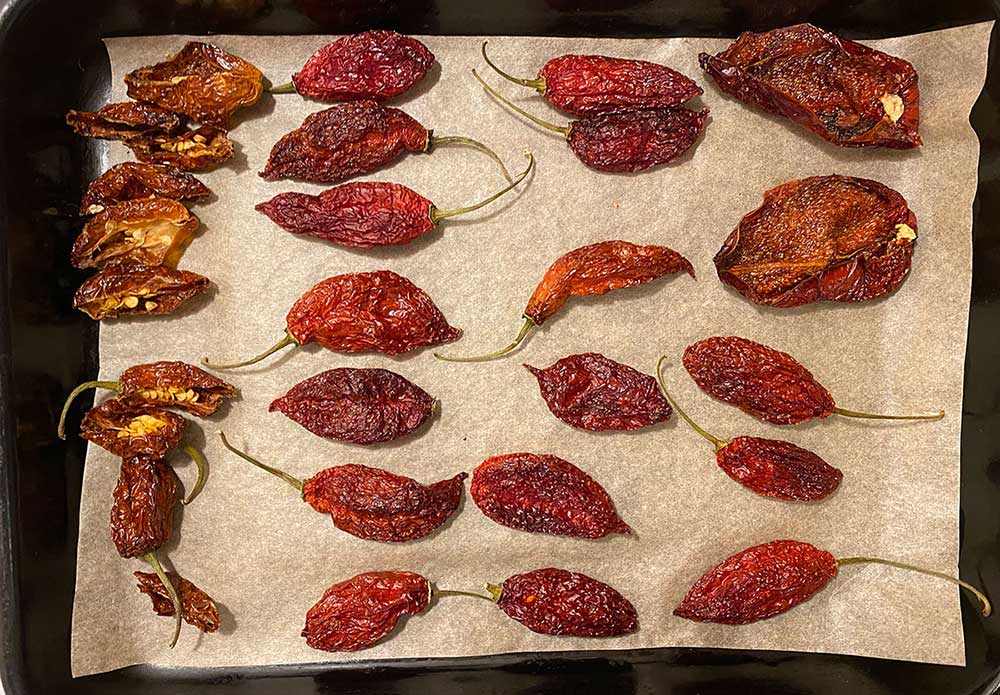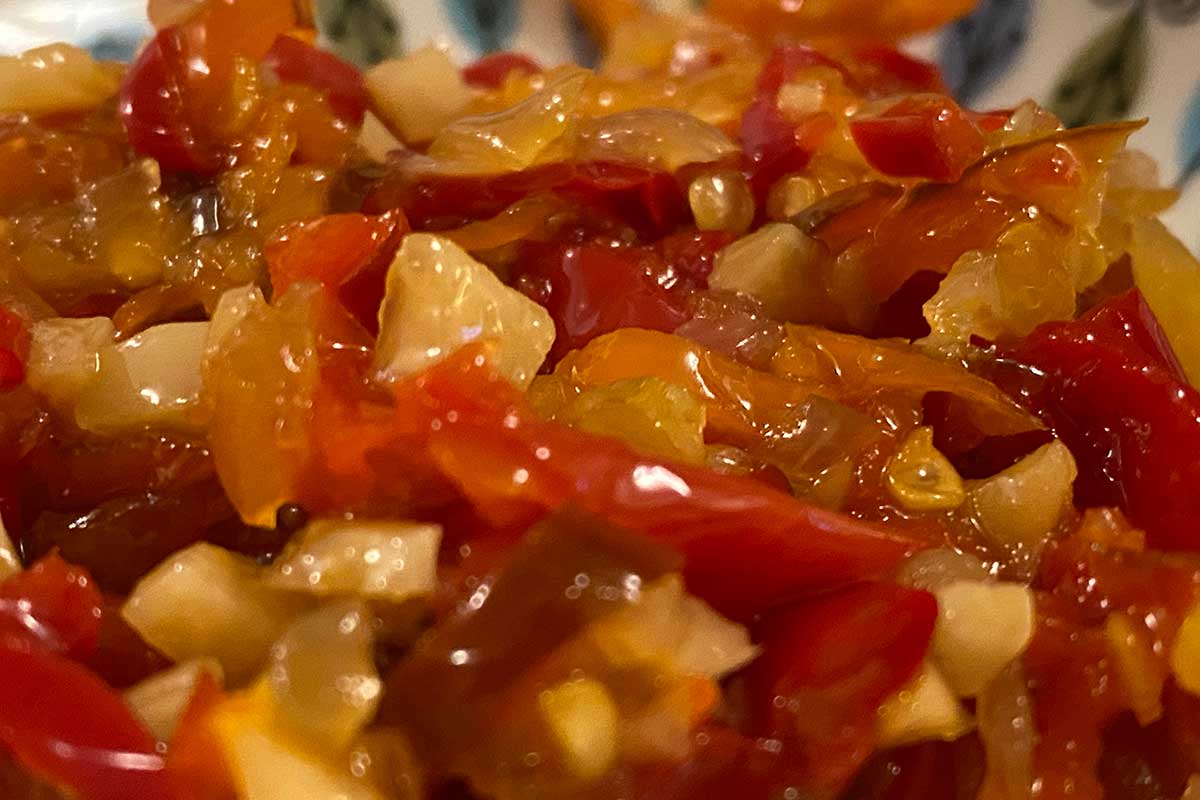When Life Gives You Peppers, Make Pepper Relish
By Ian MacAllen on Monday, November 1st, 2021 at 5:52 pm

With pumpkin spice season upon us, we did the usual thing middle-aged, once upwardly mobile professionals with a young child do and headed out of the city to pick apples in the fields of the Hudson Valley. I grew up a few miles from the Warwick, New York, the center of autumnal activities. There are plenty of u-pick apple orchards to choose from here. In recent years, traffic overwhelms the narrow roads on weekends as urban dwellers flock to nature.
We happened to choose the hottest July-in-October afternoon. Rain had been threatening all week, but we committed ourselves. We lucked out though. We had awoken early with the baby and headed out before the rest of the world realized the predicted rain was delayed. It meant a lot less traffic and fewer people in the orchard.
There are plenty of farms to choose from in the Hudson Valley. Warwick tends to be close to the city, and for me personally, my parents house. If you are unfamiliar with the Hudson Valley, grab yourself a good guide, like Easy Weekend Getaways in the Hudson Valley & Catskills, designed for weekend escapes. Or find yourself rich friends with second homes. There’s a lot to do in the Hudson Valley beyond picking apples.
In Warwick, u-pick apples has been big business since before I was kid. In addition to picking fruits, almost all of them have stores for cider, cider donuts, and bags of apples for people who don’t want to get into the field. Pennings Farm is perhaps the most famous of the Warwick orchards. They actually have two locations, plus a massive beer garden and fields of pumpkins that have been picked and repopulated to simulate the feeling of ripping a choice pumpkin from the patch it was grown in.
I’ve always avoided Pennings because of the crowds and because they tend to be more expensive, but the farm has lots of activities as if its an agricultural theme park. I prefer the less popular destinations.
On the other side of town is Maskers, an orchard that was once the hidden gem. They have made it less hidden though, and it has been growing in popularity. It’s also accessible through without getting on 94, the main state highway running through Warwick. As long as the New York State Renaissance Faire has closed for the year, 17A is a great way to avoid long lines of cars.
But perhaps my favorite is Ochs Orchard. Approaching the farm takes you down a long, narrow, twisting road through scene pastures. Since its a bit off the main highway, it feels more like a farm stand than an agriculturally themed strip mall. Ochs is a bit smaller too, and that means fewer people. The top of the orchard also has a stunning view of Warwick below.
Someone at Ochs had the brilliant idea of adding all sorts of self-pick fruit and vegetables to the fields. The added selections meant a much longer growing season — Apples only begin to ripen at the end of August and wrap up by November. That’s a rather short period of time to make all the money to sustain a farm for a year.
The fields included a wide variety of items one expects in a Hudson Valley farm. Tomatoes, green beans, and raspberries would have been available earlier in the year, and in the early fall could have found a number of late season vegetables like broccoli. We went for the hot peppers.
The apple bags the orchard sells can be filled with any of the fruits or vegetables available for picking. After picking more apples than we could reasonable consumer in a season, we headed over to the peppers. Honestly we had no idea what to expect and were pleasantly surprised to see rows and rows of hot peppers. There were numerous varieties still ripe and ready for picking. Since peppers are small and light, we topped off the apple bag and headed out just in time to avoid the promised rain.
We had plenty of ideas on how to use the apples: apple tarts, apple sauce, apple crumble, and of course, just plain apples. Peppers, on the other hand, were a bit more complicated.
I decided to dry some. We use dried pepper flakes all the time, so turning some of those bonus peppers into red pepper flakes was a brilliant idea. I knew I wasn’t going to string them up and let them air dry because I simply don’t have the patience to deal with tying each pepper off. And while pretty decorations, I wanted to use the peppers for cooking.
I checked out suggestions on temperatures. Concerned the gas oven would be too hot, I started them drying in our small electric toaster oven because it would let me set the temperature to 160°F. That was too low.
They began slowly drying out but after three hours they were only just beginning to wither. I need them to be desiccated. Finally i gave up on the little toaster oven and turned on the gas stove.
The stove is old and fickle in the best of times. The lowest temperature was 200°F, assuming it held a steady temperature.
I saw results almost immediately. With the oven door cracked, the temperature was kept low enough and the backdraft created by the open door meant a light flow of air expedited the drying process. It still took another two hours, but eventually they came out looking like this:

They are dried and preserved. Some will be crushed up for flaking onto pizza and into sauces. A few I will keep whole for those more intense projects like a braised pork shoulder.
I tried eating a slice of one. It was hotter than I expected and had to quench the burning with a thick lump of cream cheese. The relish on the other hand has a balance of heat and sweet I don’t think twice about scooping some out of the jar and eating it all by itself. Don’t try that at home.
I’ve crushed one up to toss with some Brussel sprouts, and they tasted great.
Drying the peppers wasn’t the end of the line for me, however. I still had a pile of mixed varieties.
I decided to experiment with a pepper relish. Not quite a hot sauce, and thicker than a salsa, the pepper relish is a sweet and spicy condiment.
I loosely followed a recipe chopping up the peppers and tossing them with some salt, sugar, and vinegar. I added some Hudson Valley garlic along with not so fresh store-bought onions.
The relish cooked down for about half an hour on a low simmer. I stirred it occasionally but otherwise it required very little attention. When I tasted the relish a bit too spicy, so I toned it down a bit more sugar, but otherwise it was a straight forward experiment.

The resulting pepper relish is spicy with a hint of sweetness. There is no doubt this is a hot condiment, but we’ve found a use for it on all sorts of foods from a variety of cuisines.
The peppers were a great addition to apple picking experience. I certainly had a lot more fun making pepper relish than I expected, and its been extremely versatile in what I’ve used it on.

